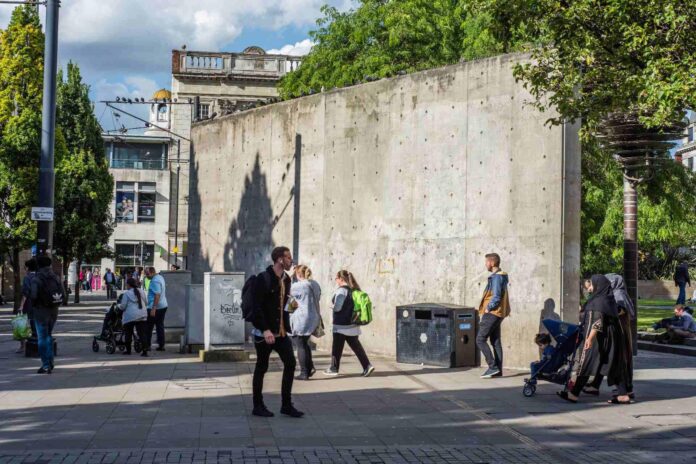As many Mancunians celebrate that the City Council will finally begin demolishing the free standing parts of Piccadilly Gardens’ infamous wall, how did the Gardens end up with the feature ?
Since the Second World War which saw the Parker Street side of the area flattened by the Luftwaffe, the Gardens and the surrounding area have been the site of many grand plans,
The 1950’s saw plans were afoot for the redevelopment of the Parker St bomb site with hotels, office blocks and shops and at its centre was a Piccadilly skyscraper, much applauded, and seen as giving a lead to the rest of the country in post war reconstruction.
This was after all the spirit of the late 50’s. brash gimcrack modernity, epitomised by the planners and developers headlong drive to bulldoze old terraced buildings, build ring roads erect tower blocks and jettison the past, hoping to emerge into some gleaming space age place.
However the scheme saw many delays, put on hold in June 1958 when the developers blamed a credit squeeze as being the reason for not going ahead at present.
Eventually it would begin, the Mayor of Manchester starting up a piledriver and released a red balloon which the Evening Chronicle announced had started the Atomic age in the city, and construction began on the concrete and glass development scheme which would culminate in a twenty-six storey office block towering 308 ft, along with a ten-storey hotel and a two-storey block of shops.
The accompanying headlines included the world’s first drive-in hotel, and a possible city centre heliport as well as an additional three-storeys. The hotel would have no doors and cars would drive through a heated air curtain into a foyer and then park on the roof of the shopping area and the building would have eight lifts travelling at 700 ft per minute.
Finally opened in 1965, the Guardian announcing that Manchester enjoyed watching it being built with the importance of the project to the city being heightened by its choice as the headquarters of the Harold Wilson’s new Regional economic planning board for the North West.
“The new plans for the city centre” it said make it look like the Northern Metropolis it has always claimed to be.
The White Heat of technology had well and truly arrived in Manchester, including putting a moving pictures advertising screen up, the first of its kind in Europe.
In many ways little has changed since the atomic days of the 60’s when The Mayor released his red balloon. The Tower remains, no longer the tallest building in Manchester, and still without a heliport and the screen continues to fire adverts across the gardens to commuters, shoppers and tourists alike
It, with many of Manchester’s sixties dreams became run down and neglected, tenants came and went and shop fronts changed around the Plaza.
Property Company Bruntwood added it to their Manchester Portfolio in 2004 for the grand price of £65m, renaming it City Tower and spending another £38m in their own words on “transforming this Manchester icon into one of the city’s most prestigious and desirable office locations.”
Architects Stephenson Bell then set to work, installing high speed lifts, air conditioning, black glass limestone and walnut finishes and installing a public mall linking it with New York Street, the council’s upgraded streetscape which runs behind the Plaza.
The Tower also has a decoration of circuit boards in homage to the first computer baby built in Manchester.
As for the wall, it was conceived by the renowned Japanese architect Tadao Ando who was charged with getting the area ready to welcome visitors to the 2002 Commonwealth Games. It was at the time, the former boxer’s first UK project, a relative unknown outside of his native country.
Its centerpiece, a gently curved concrete wall, 130 metres long, designed to shield the sunken gardens from the bus station behind and which was intended to pull off the remarkable illusion, that the walls may be built from blocks of concrete, but, from the inside at least, the building feels as if its primary materials were light and air.
In practice the ideals never happened and whether the design language of the gardens does what it intended to, which was in the words of the design company to give “a smoothness and studied simplicity which draws the eye of the beholder to the buildings that surround the square with nothing to intervene” remains to be seen.
It was a landscape supposedly designed by movement, giving the impression of an outdoor funnelling flow of people between adjoining urban districts.
Instead it has become along with the gardens itself a concrete monolith, attracting unsavoury charactors and embarrasing the City in a area which should be a showcase for visitors.
Few will lament its demise







